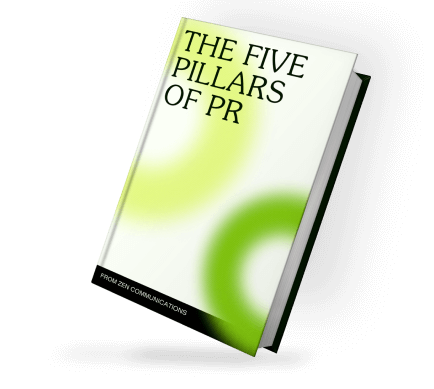Free e-book download click to download the first two chapters of ‘The Five Pillars of PR’
Picture the scene if you will… A mildly harassed company director, marketing manager or business executive picks up the phone to a journalist who asks them if they have anything to add to claims that their company has been involved in dodgy dealings of some description. Do they have a comment to add? “Well, no” adds the executive, thinking they need to get the facts together and work out what’s happened, what they can say, plus get the final statement approved by the Board.
Right move? Sadly not. While they’re still carefully crafting a killer response to refute all claims, and wading through spreadsheets to get the data to back up their denial, the morning’s paper is full of salacious details about the firm. Wild and wacky even, you can see pages 3, 4, and 5 for follow-on break-out stories with interviews of affected people and photos of old, dug up from dusty files.
And the company’s representation in all of this? “We approached Acme Limited but they declined to comment.” Ouch! For Joe Bloggs reading that, the executive may as well have said “Absolutely right, we’re guilty as hell, throw the book at us.” And once the story’s broken it’s all too little and too late to start trying to defend yourself.
The executive should take heart though, it could absolutely have been worse. They may have not taken the call or simply been unavailable, in which case “no one was available to comment” will be used instead and that’s an even tougher one to bounce back from.
So, how should you deal with a media enquiry?
Firstly, make sure that you know who should take the call, and have a reserve, and a reserve for them, and hey, a reserve for them may be a good idea too. Make sure that whoever answers the phone knows who these people are and that the journalist is put straight through. Worst case scenario? They’re all trapped in a broken-down lift together? You should have a simple ‘check-list’ of questions to ask that your receptionist can take down for you.
Basics include the journalist’s name, the title they’re calling from, their direct phone number or mobile number if they prefer, and their email address. Next you need to gently tease out as much information as possible. What’s the story about? What does he or she think has happened? And how is your company supposed to be involved? Don’t ask these questions outright, but dig around and see what you can learn as it will help you form your response. Now, and most importantly, you need to confirm that you will share a response quote with them and check their deadline.
Now, follow your communications protocol (don’t have one? Watch this blog as we’ll be covering this in a future piece) and go straight to the spokesperson of the division, company, or corporation. They should be briefly told all that’s happened and the timescales involved, and then a statement should be drafted. In an ideal world you’d have a handful of these tucked away in a secure area of the server for just such an eventuality – a kind of issues management by numbers if you will – but unless you have a PR agency with experience of protecting and defending reputations this may not be the case.
Imagining for a moment that the cupboards are bare, your start-from-scratch statement should be factual, absolutely verifiable, and succinct. Acknowledge the known details of what’s happened but don’t guess anything, express concern, and outline what you’re doing about it. And that’s it for now. So, something like: “An incident occurred on our XYZ line at 14:05 today, and while our emergency safety protocols appear to have been followed, we have stopped all production while we investigate the situation further. We understand that some delays may be experienced by our customers, and our team is working hard to support them as they need, but the quality of Acme brand is imperative and…” you get the picture.
You need to work that up in minutes, and you need a single approval point ideally. One person who can look it over and check they’re happy. Then, you get it over to your journalist contact on email, with a covering note to say you’re here to assist as they need. Share your direct contact details and make it as easy as possible for them to come back with a second or third request as the story unfolds.
And once that’s done? Immediately call your PR agency and your Board and implement your issues management plan as per the protocol. It should cover off spokespeople, statements, approaches, and timings, and you should have biographies on core people and fact-sheets on top products all ready to go. If you don’t, you have a busy few hours ahead of you, so it may be worth cancelling dinner plans…
Just remember that the journalist isn’t your enemy, they’re there to report news, but they also understand that the more dramatic and salacious a story, the better the headlines and the more copies of the title they can shift. They don’t care that you want to protect your brand, but if you treat them with the respect they deserve, if you’re relatively straightforward, and if you deliver what you say when you say, then you’re likely to develop a good reputation and maybe even a strong contact for future, more positive proactive pieces. Enjoy!


Free Download